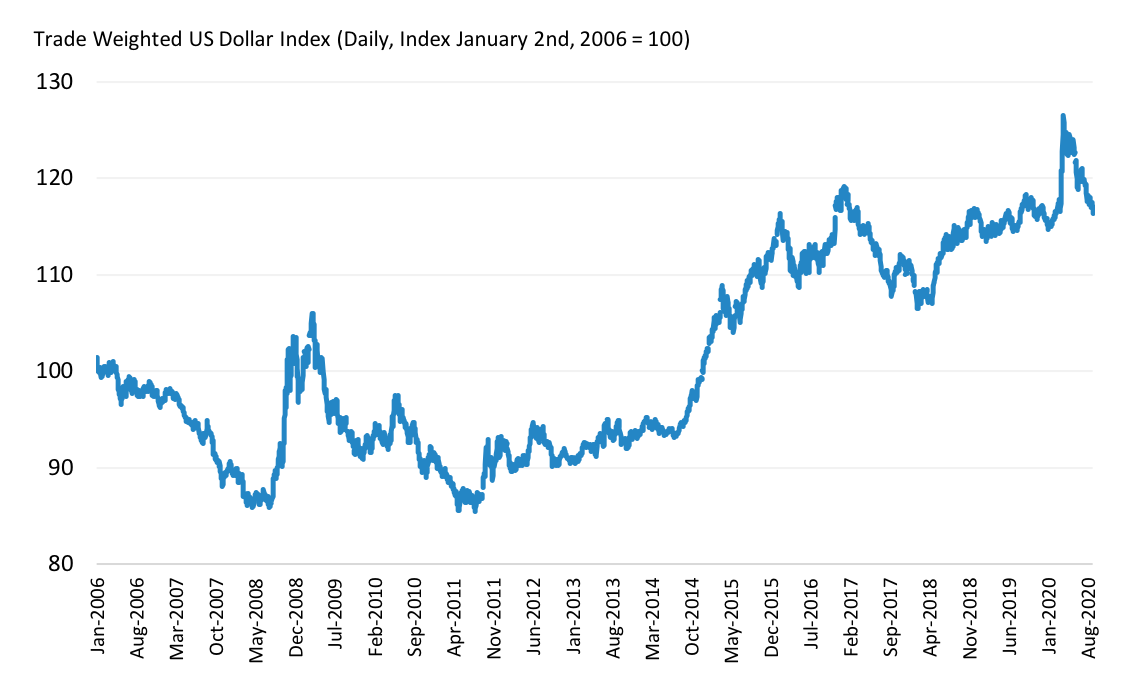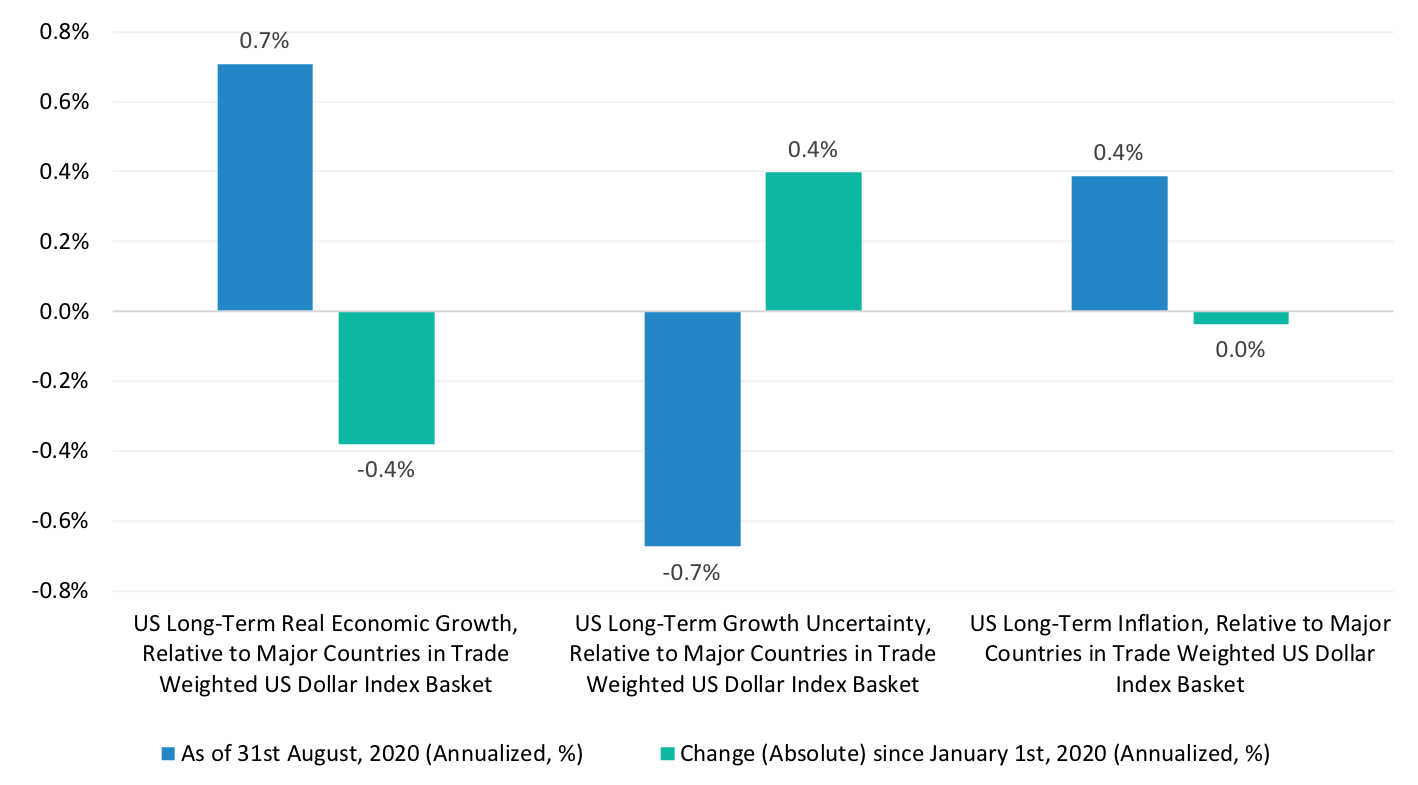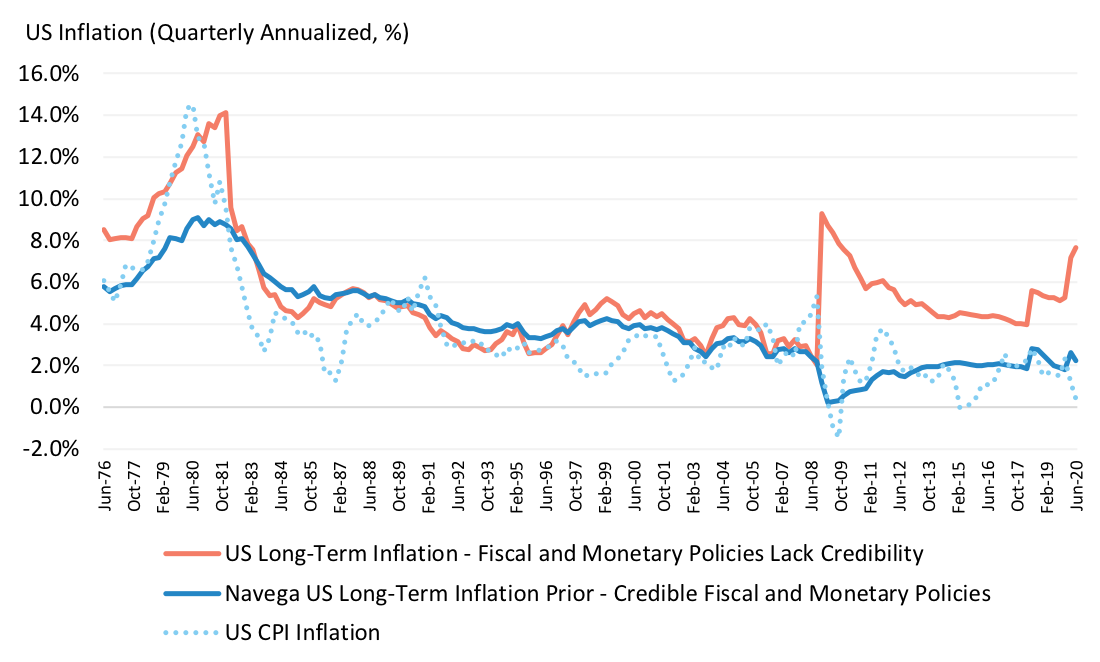
Since March, the US dollar lost about 8% of its value relative to major currencies. Some analysts pointed that this loss reflected markets' pricing of higher inflation in the US. While investors should worry about inflation risk, such concerns have not materialized yet, nor been priced into markets - as dollar denominated debt assets still maintain their privileged position as dominant reserve assets of the world. Instead, investors would be better served focusing on long-term prospects for US economic growth. According to our models, the decline in the dollar is consistent with markets' pricing of lower long-term real economic growth with higher uncertainty - and not higher inflation - relative to developed economies. Further relative deterioration in trend growth could well lead to investors losing trust in the stability of US fiscal balances and the demise of the US dollar, leading to higher inflation and potentially more volatile global financial markets.

As shown in Exhibit 1, the trade weighted US dollar index suffered a significant and sustained 8% loss since March 23rd, 2020. This fall follows unprecedented highs reached by the dollar at the start of the pandemic as investors were seeking refuge in the world's dominant safe haven currency. Compared to historical standards, though, this fall was not dramatic, and the dollar is, at this stage, far from being undervalued relative to other major currencies. However, investors are right to pay attention. According to our models, the declining trend in the trade weighted US dollar index reflects investors' pricing of relatively lower US long-term real economic growth and higher growth uncertainty compared to other benchmark countries in the index currency basket - including Eurozone, Canada, UK, and Japan - and/or higher US long-term inflation compared to these countries. The key questions then for investors are whether the recent decline in the US dollar index reflects markets' concerns about US growth, inflation, or a combination of both lower growth and higher inflation (relative to the rest of the world)? And what would further degradations in growth prospects mean for the US dollar and credibility of US fiscal balances?
Our models point to currency markets' pricing of fears of a prolonged period of relatively lower trend growth and higher growth uncertainty - and not of higher inflation. Indeed, as portrayed by Exhibit 2 and according to our models, long-term prospects for inflation for the US have remained stable over the last 8 months relative to major countries in the index currency basket, even despite the dramatic recent increase in US government borrowing. As discussed in our previous note, the main reason is that markets still have confidence in US fiscal and monetary policies. In turn, debt assets issued by the US government continue to be seen as the world's safest assets. This trust is further supported by the privileged status of the US dollar as the world's dominant reserve currency. The US dollar retains its preeminent position in part because the US remains the primary engine of global growth, as shown in Exhibit 2, and also thanks to the perceived credibility of US fiscal and monetary policies.

Moreover, Exhibit 2 suggests investors should be concerned about the recent relative changes to US long-term real economic growth, not just differences in absolute levels. Our models are consistent with markets pricing in relatively lower long-term trend growth with higher uncertainty about the trend in the US, compared to other major economies and the start of the year. These changes in trends were driven by lockdown measures, the resurgence of infections and the devastating impact of both on the labor force and output productivity. More precisely, our forecast for US long-term real economic growth fell from about 1.5% to 1% - a significant 50bps drop ! At the same time, our long-term growth and uncertainty projections, while bleak, remained broadly unchanged for the other major countries in the currency basket.

While there is no cause yet for dramatic concern, as prospects for long-term growth in the US still fare better compared to other developed economies, providing support for the US dollar and dollar denominated debt. Nevertheless, the real worry for investors is the risk of prolonged relative deteriorations in US long-term growth. These fears could well become more likely to materialize in the context of possible untamed resurgence(s) in Covid-19 infections in the US and worldwide and unprecedented (and unmanaged) levels of US government debt. In such a doomsday scenario, investors could be quick to distrust US fiscal balances and revisit the privileged position of the US dollar denominated debt assets. A run on the dollar and US government debt, according to our models and as depicted in Exhibit 3, would lead to spiraling inflation rates similar to the 1970s experience or perhaps even worse , along with global financial instability.
Going forward, investors are well advised to monitor changes to the main drivers of long-term growth - growth in the labor force and total factor productivity - in the US and globally, and their impact on US fiscal balances, the privileged status of the US dollar, portfolio returns and strategies.
This document is for informational purposes only. This document is intended exclusively for the person to whom it has been delivered, and may not be reproduced or redistributed to any other person without the prior written consent of Navega Strategies LLC (“Navega”). The information contained herein is based on Nageva’s proprietary research analytics of data obtained from third party statistical services, company reports or communications, publicly available information, or other sources, believed to be reliable. However, Navega has not verified this information, and we make no representations whatsoever as to its accuracy or completeness. Navega does not intend to provide investment advice through this document. This document is in no way an offer to sell or a solicitation of an offer to buy any securities. Investing in securities involves risk of loss, including a loss of principal, that clients should be prepared to bear. Past performance is not indicative of future results, which may vary materially. While this summary highlights important data, it does not purport to capture all dimensions of risk. The methodology used to aggregate and analyze data may be adjusted periodically. The results of previous analyses may differ as a result of those adjustments. Navega has made assumptions that it deems reasonable and used the best information available in producing any calculations herein. Statements that are nonfactual in nature, including opinions, projections and estimates, assume certain economic conditions and industry developments and constitute only current opinions that could be incorrect and are subject to change without notice. All information provided herein is as of the delivery date the document (unless otherwise specified) and is subject to modification, change or supplement in the sole discretion of Navega without notice to you. This information is neither complete nor exact and is provided solely as reference material with respect to the services offered by Navega. Information throughout this document, whether stock quotes, charts, articles, or any other statement or statements regarding market or other financial information, is obtained from sources which we and our suppliers believe reliable, but we do not warrant or guarantee the timeliness or accuracy of this information. The information presented here has not been personalized, and is not based on the financial circumstances of the recipient. This information may not be applicable to your particular financial needs, and should not, by itself, be used to make determinations regarding the purchase or sale of securities, or other investment decisions.
The model performance information presented is based on the application of Navega’s factor analysis, backtested against actual historical data. “Backtesting” is a process of objectively simulating historical performance information by applying a set of rules backward in time. The results of the application of Navega’s model do not reflect actual performance or actual historical data. Such models are prepared with the full benefit of hindsight, and it is not likely that similar results could be achieved in the future.
The model portfolios were constructed by Navega with the benefit of hindsight to illustrate certain performance metrics. The performance shown was not actually achieved by any investor. The investments in these hypothetical portfolios were selected with the full benefit of hindsight, after performance over the period shown was known. It is not likely that similar results could not be achieved in the future. The hypothetical portfolios presented here are purely illustrative, and representative only of a small sample of possible scenarios.
The projections shown do not represent actual performance, and are based on assumptions which may not occur. It is possible that the markets will perform better or worse than shown in the projections, the actual results of an investor who invests in the manner these projections suggest will be better or worse than the projections, and an investor may lose money by relying on these projections.